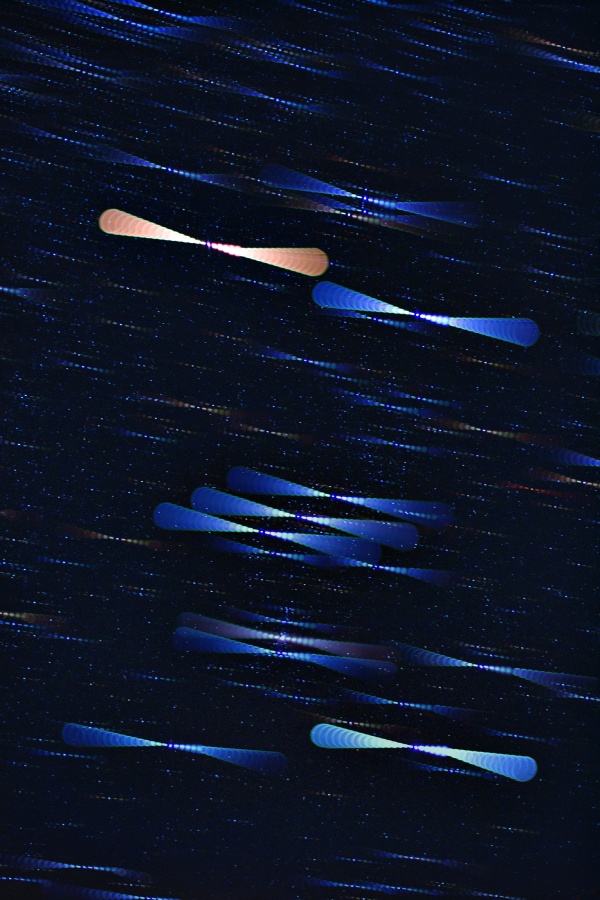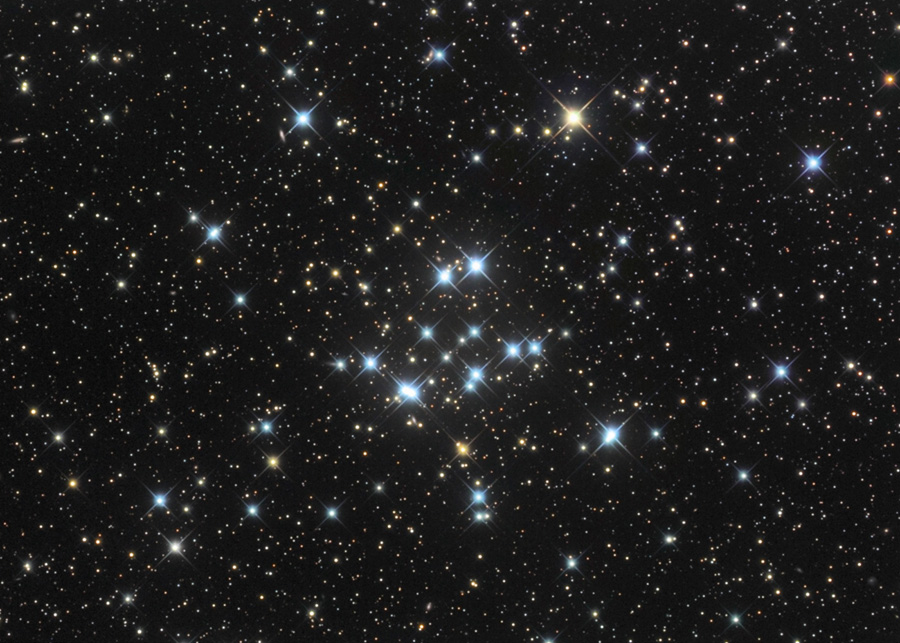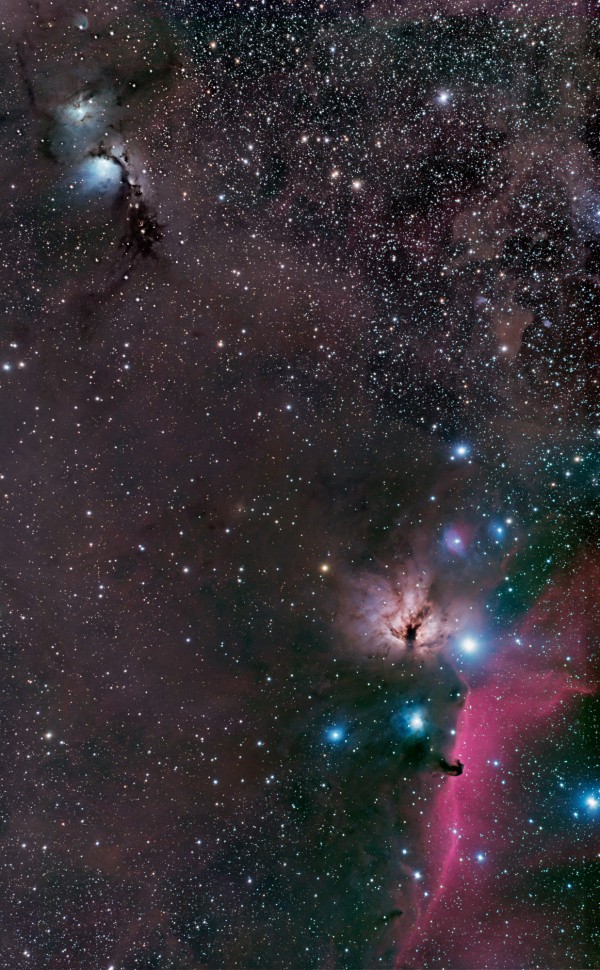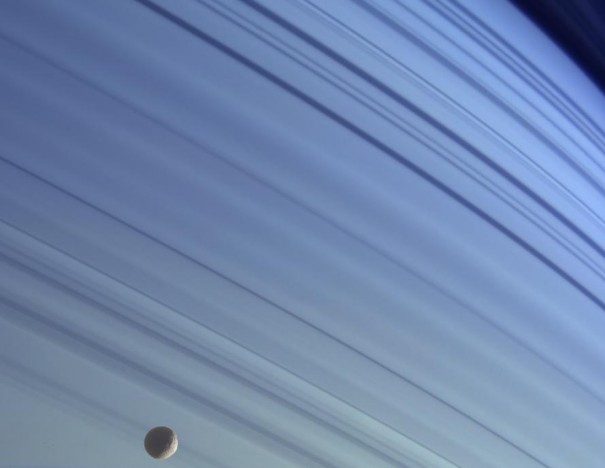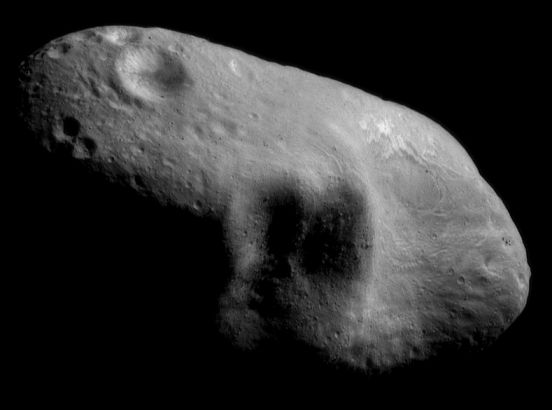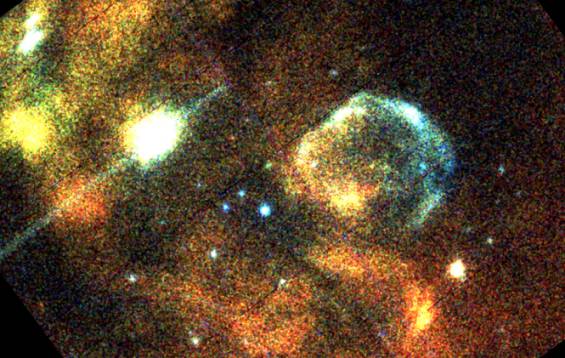| << Previous | Index | Next >> |
2015 Majestic on a truly cosmic scale, M100 is appropriately known as a grand design spiral galaxy. It is a large galaxy of over 100 billion stars with well-defined spiral arms that is similar to our own Milky Way Galaxy. One of the brightest members of the Virgo Cluster of galaxies, M100 (alias NGC 4321) is 56 million light-years distant toward the constellation of Berenice's Hair (Coma Berenices). This Hubble Space Telescope image of M100 was made in 2006 and reveals bright blue star clusters and intricate winding dust lanes which are hallmarks of this class of galaxies. Studies of variable stars in M100 have played an important role in determining the size and age of the Universe. If you know exactly where to look, you can find a small spot that is a light echo from a bright supernova that was recorded a few months before the image was taken.
2014 Is the heart and soul of our Galaxy located in Cassiopeia? Possibly not, but that is where two bright emission nebulas nicknamed Heart and Soul can be found. The Heart Nebula, officially dubbed IC 1805 and visible in the above zoomable view on the right, has a shape reminiscent of a classical heart symbol. Both nebulas shine brightly in the red light of energized hydrogen. Several young open clusters of stars populate the image and are visible above in blue, including the nebula centers. Light takes about 6,000 years to reach us from these nebulas, which together span roughly 300 light years. Studies of stars and clusters like those found in the Heart and Soul Nebulas have focussed on how massive stars form and how they affect their environment.
2013 Massive stars, abrasive winds, mountains of dust, and energetic light sculpt one of the largest and most picturesque regions of star formation in the Local Group of Galaxies. Known as N11, the region is visible on the upper right of many images of its home galaxy, the Milky Way neighbor known as the Large Magellanic Clouds (LMC). The above image was taken for scientific purposes by the Hubble Space Telescope and reprocessed for artistry by an amateur to win the Hubble's Hidden Treasures competition. Although the section imaged above is known as NGC 1763, the entire N11 emission nebula is second in LMC size only to 30 Doradus. Studying the stars in N11 has shown that it actually houses three successive generations of star formation. Compact globules of dark dust housing emerging young stars are also visible around the image.
2012 Lighting the night last Tuesday, February's Full Moon is sometimes called the Snow Moon. But the Moon was not quite full in this mosaicked skyscape recorded on February 2 south of Budapest, Hungary, and there was no snow either. Still, thin clouds of ice crystals hung in the cold, wintry sky creating this gorgeous lunar halo. Refraction of moonlight by the six-sided crystals produce the slightly colored halo with its characteristic radius of 22 degrees. Just below the Moon is bright star Aldebaran. Also well within the halo at the right is the Pleiades star cluster. At the lower left, near the halo's edge lie the stars of Orion with bright Capella, alpha star of the constellation Auriga, just beyond the halo near the top of the frame.
2011 What determines a star's color? Its temperature. Red stars are cool, with surface temperatures of around 3,000 kelvins (K), while blue stars are hotter and can have temperatures over 30,000 K. Our own lovely "yellow" Sun's temperature is a comforting 6,000 K. Differences in star colors are particularly easy to see in this intriguing composite view of the constellation Orion, made while experimenting with a star trail step-focus technique. In it, a series of 35 consecutive exposures were combined to produce trails of stars moving left to right through the frame, while changing focus in steps. Beginning and ending with the camera out of focus produced a sharply focused exposure near the middle of the series and blurs the star trails into a bow tie shape. For the brighter stars, blurring produces more saturated colors in the images. At the upper left, Orion's cool red supergiant Betelgeuse stands out from the other, hotter, bluish stars composing the body of the constellation. Not a star at all, the Orion Nebula contributes a pinkish tint below center. Also remarkable in the field, the fainter step focus trail of cool, deep red carbon star W Orionis is near the center right edge, its red hue enhanced by a carbon-rich composition.
2010 This pretty, open cluster of stars, M34, is about the size of the Full Moon on the sky. Easy to appreciate in small telescopes, it lies some 1,800 light-years away in the constellation Perseus. At that distance, M34 physically spans about 15 light-years. Formed at the same time from the same cloud of dust and gas, all the stars of M34 are about 200 million years young. But like any open star cluster orbiting in the plane of our galaxy, M34 will eventually disperse as it experiences gravitational tides and encounters with the Milky Way's interstellar clouds and other stars. Over four billion years ago, our own Sun was likely formed in a similar open star cluster.
2009 Yesterday's skyscape featured Alnitak, Alnilam, and Mintaka, the stars of Orion's Belt. Today's also presents the easternmost belt star, Alnitak, at the bottom right of the field, surrounded by the well-known Horsehead and Flame nebulae. But this view sweeps farther to the east (left) and north (top) detailing subtler cosmic clouds of gas and dust scattered through the fertile, nebula rich region. The scene is anchored at the top left by the eerie blue glow and ominous dark dust lanes of reflection nebula M78. Like the Horsehead, the Flame, and the Orion Nebula itself, M78 is a readily visible part of the large Orion Molecular Cloud complex some 1,500 light-years distant.
2008 How did Epimetheus form? No one is yet sure. To help answer that question, this small moon has recently been imaged again in great detail by the robot spacecraft Cassini now orbiting Saturn. Epimetheus sometimes orbits Saturn in front of Janus, another small satellite, but sometimes behind. The above image, taken last December, shows a surface covered with craters indicating great age. Epimetheus spans about 115 kilometers across. Epimetheus does not have enough surface gravity to restructure itself into a sphere. The flattened face of Epimetheus shown above might have been created by a single large impact.
2007 What's happening on Jupiter's moon Io? Two sulfurous eruptions are visible on Jupiter's volcanic moon Io in this color composite image from the robotic Galileo spacecraft that orbited Jupiter from 1995 to 2003. At the image top, over Io's limb, a bluish plume rises about 140 kilometers above the surface of a volcanic caldera known as Pillan Patera. In the image middle, near the night/day shadow line, the ring shaped Prometheus plume is seen rising about 75 kilometers above Io while casting a shadow below the volcanic vent. Named for the Greek god who gave mortals fire, the Prometheus plume is visible in every image ever made of the region dating back to the Voyager flybys of 1979 - presenting the possibility that this plume has been continuously active for at least 18 years. The above digitally sharpened image was originally recorded in 1997 on June 28 from a distance of about 600,000 kilometers.
2006 The dark-floored, 95 kilometer wide crater Plato (top) and sunlit peaks of the lunar Alps are highlighted in this sharp digital mosaic of the Moon's surface. While the Alps of planet Earth were uplifted over millions of years as continental plates slowly collided, the lunar Alps were likely formed by a sudden collision that created the giant impact basin known as the Mare Imbrium (Sea of Rains). The mare's generally smooth, lava-flooded floor is seen extending to the left. The prominent straight feature cutting through the mountain range (lower right) is the lunar Alpine Valley, about 160 kilometers long and up to 10 kilometers wide. Of course, the large, bright alpine mountain near bottom center is named Mont Blanc and reaches over 3 kilometers above the lunar surface. Lacking an atmosphere, not to mention snow, the lunar Alps are probably not an ideal site for the Winter Olympic Games. Still, a 150 pound skier would weigh a mere 25 pounds on the Moon.
2005 Serene blue hues highlight this view of Saturn's northern hemisphere from the Cassini spacecraft. The image has been adjusted to approximate the natural blue color of visible sunlight scattered by the gas giant's upper atmosphere. Saturn's famous rings cast the dark shadows stretching across the frame with infamous cratered moon Mimas lurking at the lower left. Orbiting beyond the main inner rings, Mimas itself is 400 kilometers across and lies nearly 200,000 kilometers, over 3 Saturn radii, from the center of the planet. Still, Mimas orbits within Saturn's faint and tenuous outer E ring.
2004
2003 What causes unusual knots of gas and dust in planetary nebulas? Seen previously in the Ring Nebula, the Helix Nebula, and the Eskimo Nebula, the knots' existence was not predicted previously and still not well understood. Pictured above is a newly released image of the Dumbbell Nebula by the Hubble Space Telescope showing details of its gaseous knots. Also visible are many bright young stars and dark sheets of interstellar dust. The Dumbbell Nebula, also known as M27, is a planetary nebula thought similar to what our Sun will become when it runs out of core fuel for nuclear fusion. Recent study of similar cometary knots indicates that they include concentrations of relatively cold molecular gas and that they change significantly as the planetary nebula ages.
2002 An eerie blue glow and ominous columns of dark dust highlight M78, one of the brightest reflection nebula on the sky. M78 is visible with a small telescope toward the constellation of Orion. The dust not only absorbs light, but also reflects the light of several bright blue stars that formed recently in the nebula. The same type of scattering that colors the daytime sky further enhances the blue color. M78 is about five light-years across. M78 appears above only as it was 1600 years ago, however, because that is how long it takes light to go from there to here. M78 belongs to the larger Orion Molecular Cloud Complex that contains the Great Nebula in Orion and the Horsehead Nebula.
2001 Orbiting asteroid 433 Eros, 145 million miles from Earth, NASA's NEAR spacecraft has been returning stunning views as its year long mission of exploration nears completion. A mosaic of NEAR images recorded at a range of about 127 miles, this picture illustrates some of the amazing contrasts which apparently exist within the domain of this diminutive world. Features as small as 65 feet are visible here, while long shadows emphasize the differences in the cratered regions at the left and smooth grooved terrain at right. Up close, the undulating surface seems flecked with bright deposits and peppered with enormous boulders. Last year, NASA changed the spacecraft name from NEAR to NEAR-Shoemaker in honor of the late Dr. Eugene M. Shoemaker, legendary geologist, comet hunter, and inspirational pioneer in the field of interplanetary science. Tomorrow, NEAR-Shoemaker will complete its scheduled mission as it will be commanded to descend to the surface of the ancient asteroid.
2000 Recently the European Space Agency released this and other spectacular "first light" pictures from its new orbiting x-ray observatory, christened XMM-Newton. A churning region of star birth and death in our small neighboring galaxy, the Large Magellanic Cloud (LMC), this field was one of several chosen to test out XMM-Newton's x-ray imaging capabilities. The picture is a false-colour one in which low energy x-rays are translated to red, medium energy to green, and high energy to blue. Image colours therefore represent the relative million degree temperatures of the x-ray emitting regions, red being the coolest and blue the hottest. Remains of the star that exploded as Supernova 1987a appear here as the white x-ray source at the lower right, while another supernova remnant, cataloged as N157D is the brightest source at the upper left. The bluish arc (near center) also appears to be a supernova remnant whose expanding debris cloud is interacting with the LMC's local interstellar gas.
1999 Planets condense from disks. Several new Hubble Space Telescope pictures of stars surrounded by disks were released earlier this week. Since the glare of the central star usually makes a surrounding disk hard to see, prior observations in radio and infrared light were used to isolate systems where the disk was edge-on, blocking much of the central starlight. One such disk system, Haro 6-5B, is shown above in false color. Here, the central disk confines the emitted light into an hourglass shape. Complex dust clouds appear dark. A powerful protruding jet is shown in green. This budding planetary system measures 0.2 light-years across. Quite possibly, our own Solar System looked like this about 5 billion years ago.
1998 Pulsars are rotating neutron stars, born in the violent crucibles of supernova explosions. Like cosmic lighthouses, beams of radiation from surface hotspots sweep past our viewpoint creating pulses which reveal the rotation rates of these incredibly dense stellar corpses. The most famous pulsar of all is found in the nearby supernova remnant, the Crab Nebula. The Crab's young pulsar is fast. Rotating at 33 times a second, its radiation energizes the surrounding gaseous stellar debris. But using archival observations from orbiting X-ray telescopes, astronomers have recently identified another "Crab-like" pulsar that is even faster. Located in the Large Magellanic Cloud (LMC), X-ray pulses from this newly discovered pulsar, in the supernova remnant N157B, indicate an even faster rotation rate - 62 times a second - making it the fastest known pulsar associated with a supernova remnant. This contoured, false color X-ray image of a portion of the LMC shows the location of N157B along with the core of the nearby hot star cluster R136, and the site of another Crab-like pulsar in SNR 0540-69.3 (rotating a mere 20 times a second). The image is about 1,500 light-years across.
1997 Astronaut Carl Walz waves at his colleagues from the aft end of the Space Shuttle Discovery's payload bay - during a 1993 spacewalk to evaluate tools, tethers, and a foot restraint slated for use in the first Hubble Space Telescope servicing mission. Today's successful launch of Discovery begins the second servicing mission to the Hubble. Discovery's crew will rendezvous with the orbiting telescope and capture it with the shuttle's manipulator arm. With Hubble in the payload bay the crew will conduct spacewalks to replace two existing instruments with new ones. To be installed are the Space Telescope Imaging Spectrograph and the Near Infrared Camera and Multi-Object Spectrometer. Other hardware will also be replaced and upgraded including the telescope's Fine Guidance Sensor. The improved instrumentation will extend the Hubble's ability to explore the distant Universe.
1996 Sputnik means "traveling companion". In stark contrast to this innocent sounding name, the launch of the Earth's first "artificial moon", Sputnik 1, by the Soviets on October 4, 1957 shocked the free world, setting in motion events which resulted in the creation of NASA and the race to the Moon. Sputnik I was a 184 pound, 22 inch diameter sphere with four whip antennas connected to battery powered transmitters. The transmitters broadcast a continuous "beeping" signal to an astounded earthbound audience for 23 days. A short month later, on November 3, the Soviets followed this success by launching a dog into orbit aboard Sputnik 2.
| << Previous | Index | Next >> |




